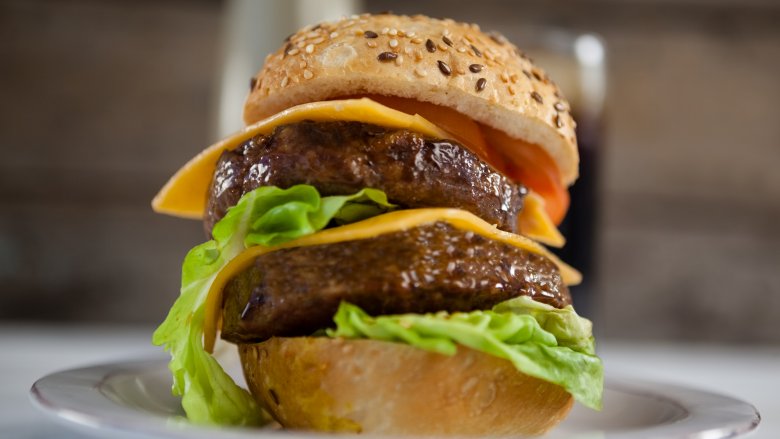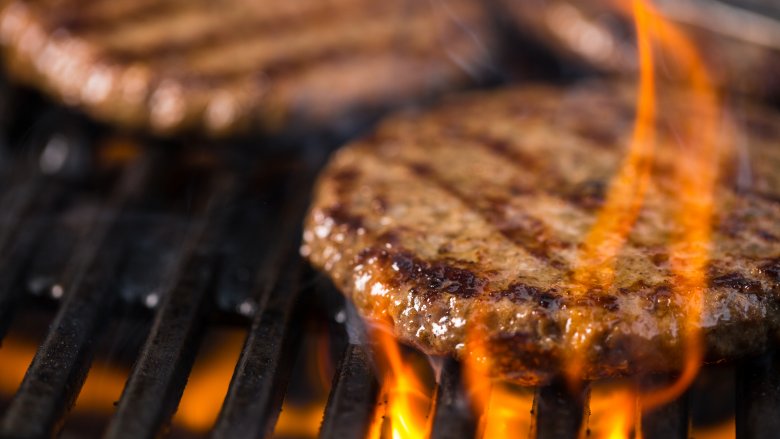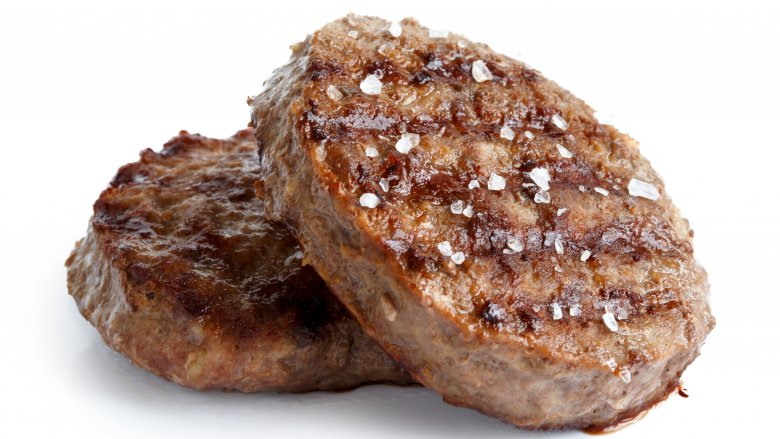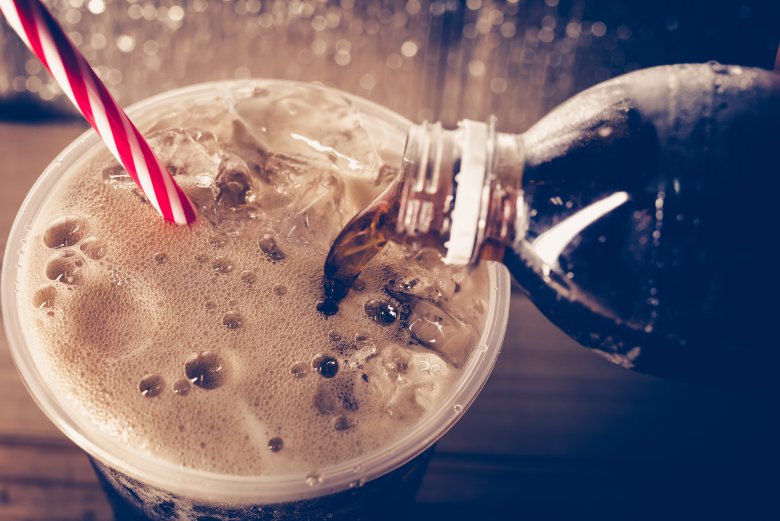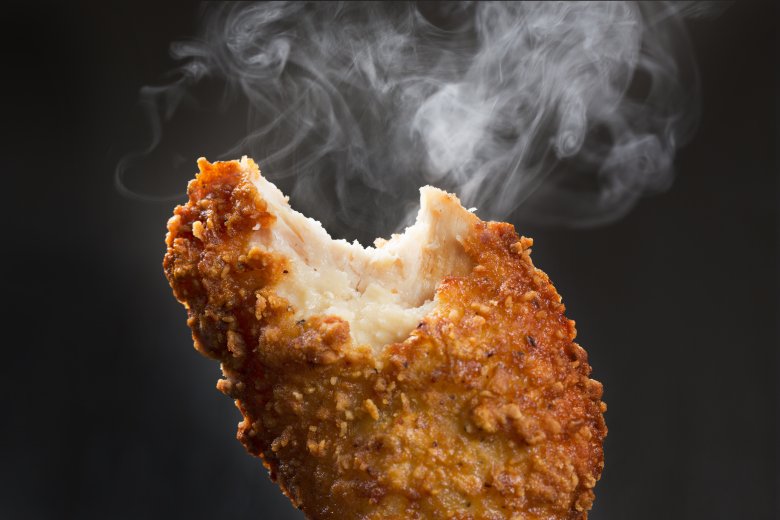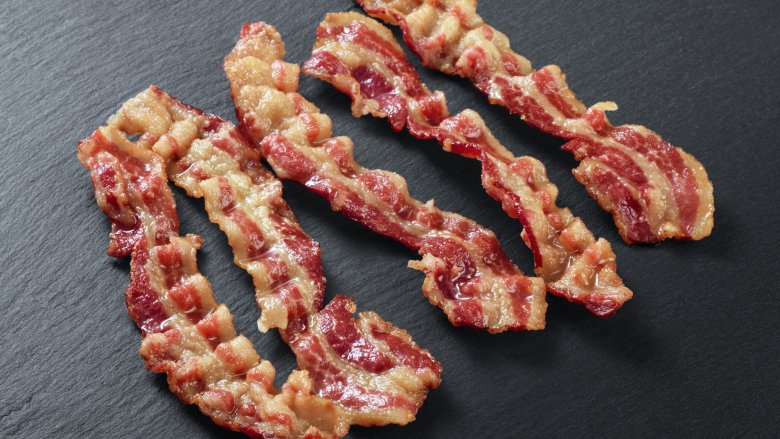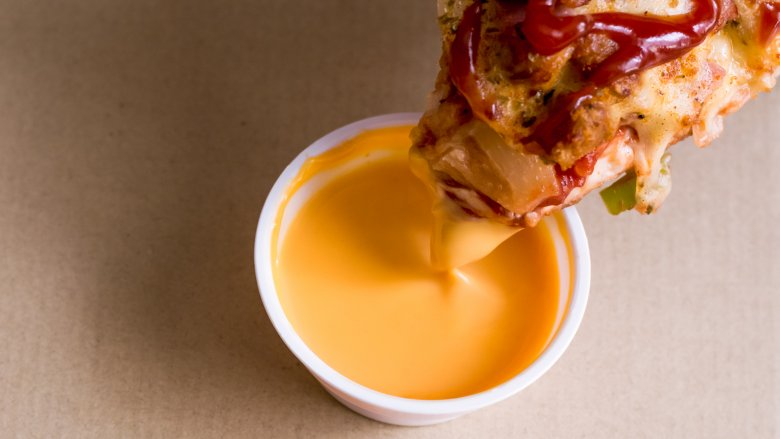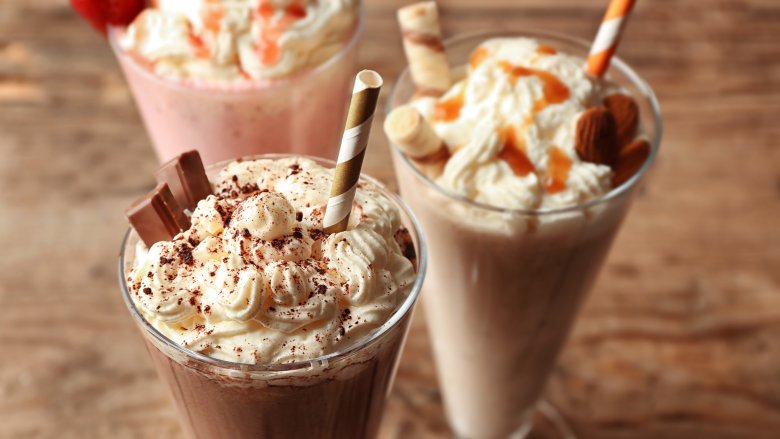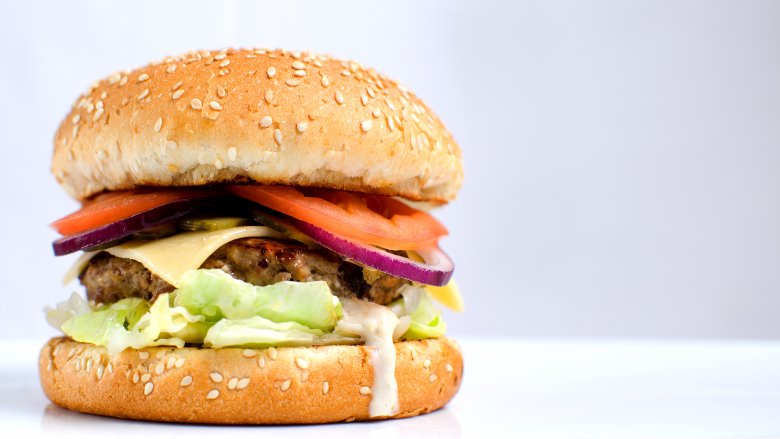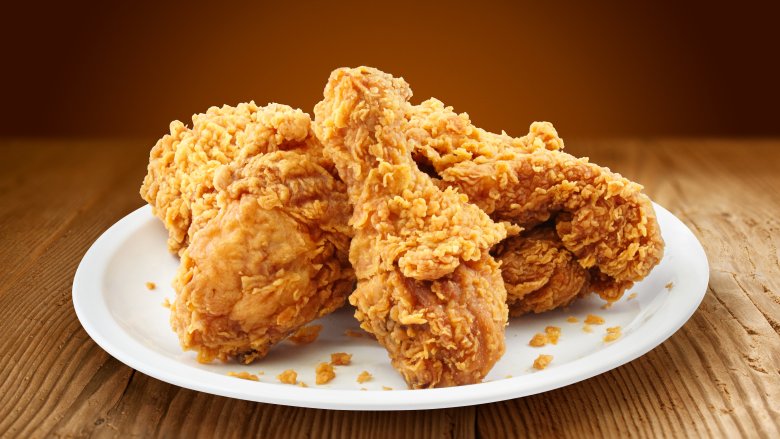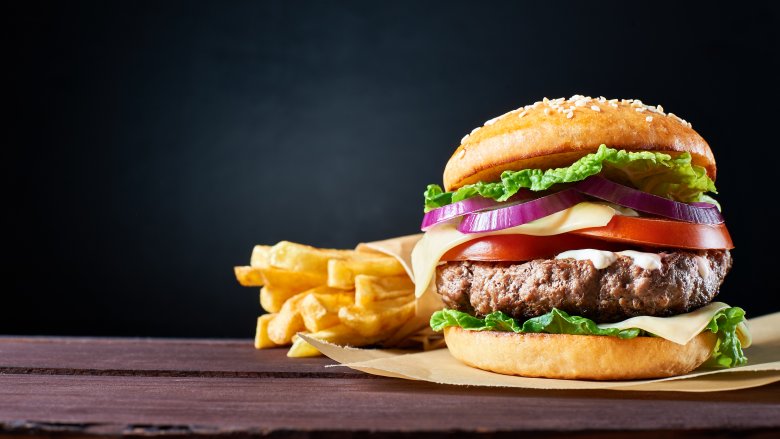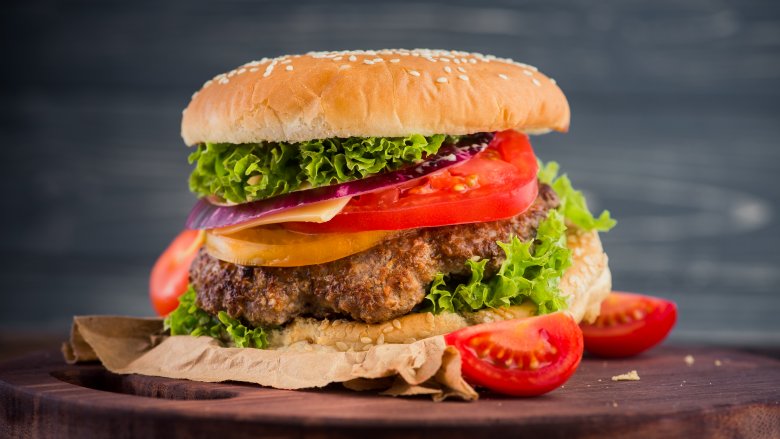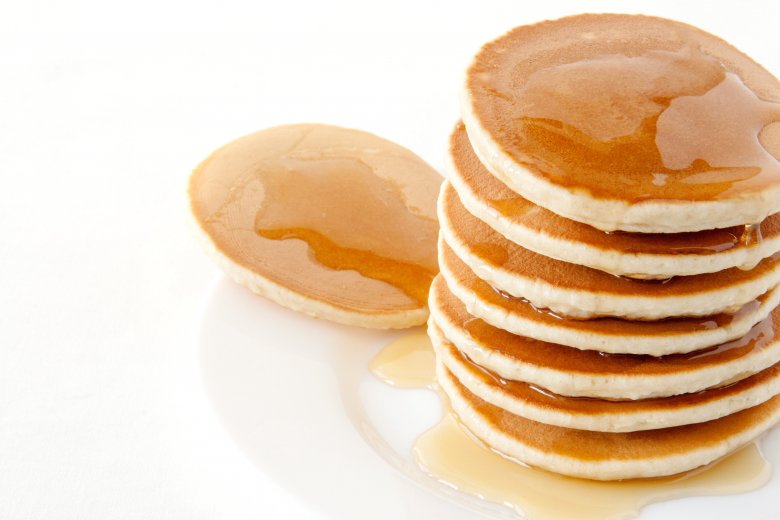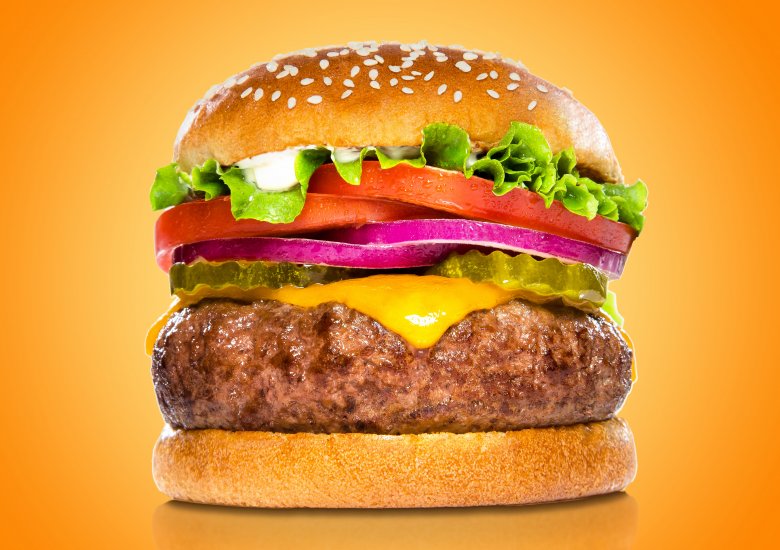Sneaky Reasons Fast Food Always Looks Better In Commercials
We've all been there — after being lured to the nearest fast food joint by that commercial promising utter perfection in a paper sack, we're astounded when we pull out a sad, squished, soggy burger. So what happened to that juicy patty with flawless grill marks topped with the reddest tomato slices you've ever seen, crisp pickles, dewy lettuce, all enveloped by a fluffy, toasted bun?
Bad news: You wouldn't want to chow down on that perfect burger, or that perfect stack of pancakes, or that perfect fried chicken leg you see in the ads because, spoiler alert, they're probably inedible. Unless you don't mind a little shoe polish or motor oil in your meal...
Prepare to be astounded by all the sneaky ways advertisers make fast food look so amazing.
The burger patties are undercooked
Ever wonder why that half pound burger pictured on the menu looks more like a quarter pounder in real life? The patty in the photo is probably undercooked. Food stylists do this to make them appear juicier and more plump than their well-done counterparts which come with a fair amount of shrinkage. If you like your burgers this side of raw, you might be able to get close, but otherwise don't count on your sandwich matching the ad.
The grill marks are added after cooking
Although the ads would have you believe it with those perfect grill marks, our $2 burgers probably aren't being cooked over a blazing fire. No, those grill marks are added after the patties have been cooked, and there are several ways food stylists achieve the look. One method is to use an electric charcoal starter (you know, the thing Kevin McCallister hung on the doorknob in Home Alone to thwart the bad guys?). By pressing the screaming hot tool onto the meat, Instagram-worthy lines are created without needing a grill. Heated metal skewers can be used in the same way to create the illusion of grill marks. Another way to fake it? Grab your favorite eyeliner or eyebrow pencil and draw 'em on. Yep, really.
And then they're still painted with shoe polish
So after the undercooked patty gets its grill mark treatment, it still might need a little touching up. That's where the shoe polish comes in. To make the burger appear even more irresistible, the same thing you use to shine your boots gets painted on anywhere a bit of extra faux char is needed.
Antacids are added to drinks
Even if you don't really want a soda, it's hard to resist the images of those tantalizingly fizzy drinks. But how often do you order a Coke only to take a sip of the flattest soda you've ever tasted? It shouldn't come as a surprise, but the bubbles you see in commercials are probably artificial, created by adding antacids to the glass. Maybe just stick to water...
The steam is fake
Fresh and steamy food just speaks to you, doesn't it? Unsurprisingly, advertisers know that, which is why those burgers, fries, and chicken strips appear to be steamin' hot in photos and commercials. Also unsurprisingly, that steam is fake. What is surprising is that one method used to create fake steam is a microwaved water-soaked tampon hidden behind the food. The hot cotton gives off a steady stream of steam, and voila, that food is calling your name even louder. Cotton balls and sponges can be used in place of a tampon, and clothes steamers are also used. No matter what the method though, you can bet the food isn't hot enough to be giving off steam of its own.
The bacon is cooked just so
The reality of most bacon-adorned fast food sandwiches is that the strips are flat, limp, and generally give bacon a bad name. So why does it look so good in ads? It's because food stylists are paying a lot of attention to that pork product, cooking the bacon by weaving it over and under tubes before it goes into the oven, which creates the perfect ribbon effect. Obviously, nobody is spending that kind of time on the bacon in the fast food kitchen.
The sauces have wax added
Picture those mouthwatering burgers with the barbecue sauce dripping down the sides, or that cheesy dipping sauce you just want to eat with a spoon. Chances are those sauces have wax mixed in, and that's to combat separating and dullness. Wax ensures the condiments stay cohesive for long photo shoots, and provides that extra pop of color the cameras love.
Ice cream isn't really ice cream
If you tasted the frozen treats in a fast food ad, you'd be in for quite a shock. Instead of delicious ice cream, you might get a mouthful of mashed potatoes, vegetable shortening, and powdered sugar. And instead of a creamy milkshake, you could be sipping on shortening, powdered sugar, and Jell-O. And that whipped topping? Probably shaving cream. These stand-ins don't melt like the real thing, so they're preferable under the hot lights of a shoot.
Buns are meticulously chosen
We're all familiar with the burger whose bun looks like it got run over before being placed in its rightful spot atop the patty, but you'd never see an ad portraying such an atrocity. That's because the buns you see in ads have beaten out hundreds of competitors — yes, food stylists really sift through that many in their search for perfection. And after all that, individual sesame seeds still might get glued on to make it really shine. Talk about tedious.
The fried chicken has a secret ingredient
Chicken pieces, like any meat, come with their own imperfections and irregularities. That's nature, right? But the chicken you see in ads is always perfect, so what gives? To make fried chicken look plump in spots it might be lacking volume, mashed potatoes can be injected under the skin to fill it out. It's like Juvéderm for your drumstick.
The burgers are full of inedible objects
One of the biggest differences you might notice between the burger in ads and the real thing is the height of the sandwich. That's because food stylists are actively fighting gravity with cardboard and pins. The cardboard is used between layers to keep anything from sinking and squishing together, while the pins are used to keep everything exactly where it should be. Maybe it wouldn't be delicious to eat, but it sure looks good.
The produce isn't really that fresh
When was the last time you were actually impressed by the produce on your burger? The ads would have you believe that it's so ripe, so fresh, so juicy, but in reality? It's just not — tomatoes are pale, lettuce is wilted, pickles aren't crisp. Of course, there's a way to fix all that in ads. Aside from choosing the best of the best for the toppings, a spritz of glycerin or hairspray perks those veggies up and gives the shot its ubiquitous dew drops. Unfortunately, hairsprayed tomatoes are no better than unripe tomatoes, so it doesn't do us much good in real life.
The pancakes are full of lies
Fast food ads make pancakes look so tempting, but the stack from the photo shoot is the last thing you want to start your day. For starters, the flapjacks are probably sprayed with Scotchgard to keep the "syrup" from soaking in. Why the quotes? We're not talking about fake syrup in the sense that it contains corn syrup and didn't come from a maple tree. No, we're talking about motor oil. The inedible substitute is used because the real thing isn't dark enough. Worst pancakes ever.
Hours are spent on each burger
In an effort to be transparent, McDonald's allowed consumers behind the scenes of a photo shoot to see exactly how things are done. While it turns out that they don't employ any of the sneakiest tricks like using shoe polish on their patties, they do take hours to construct that perfect burger, and every ingredient used is the best version of itself. Syringes place ketchup and mustard, tweezers place onions — it's the most precisely made burger you'll ever see. And that's exactly why it looks so darn good.
And even then they're still photoshopped
Even after all that meticulous prep and expert placement of ingredients, you'd better believe the final image still gets photoshopped. Just like human models, burger models get the once-over to remove blemishes, fix any imperfections, and enhance coloring. Maybe someday the ban on digitally altered photos will extend to food?
Robots are used
Ever wonder how fast food commercials make things literally fall into place in one perfect shot? The answer is robots and rubber bands, and it's pretty cool to watch.
